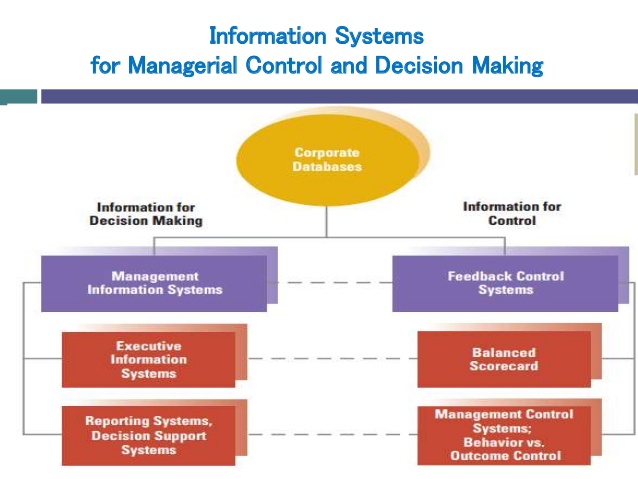Organizational Decision-Making Systems
Management Information Systems
Management information systems—including information reporting systems, decision support systems, and executive information systems—facilitate rapid and effective decision making.
Elements for control include various management control systems, including executive dashboardsOpens in new window, and a procedure known as the balanced scorecardOpens in new window. In an organization, these systems are interconnected, as illustrated by the dashed lines in Figure X2 (shown below).
A management information system (MIS) is a computer-based system that provides information and support for managerial decision making.
The MIS is supported by the organization’s transaction processing systems and by organizational and external databases.
- The information reporting system, the most common form of MIS, provides mid-level managers with reports that summarize data and support day-to-day decision making. For example, when managers need to make decisions about production scheduling, they can review data on the anticipated number of orders within the next month, inventory levels, and availability of human resources.
 Figure XII Information Systems for Managerial Control
Figure XII Information Systems for Managerial Control |
The systems for decision making and control often share the same basic data, but the data and reports are designed and used for a primary purpose of decision making versus control.
At Harrah’s casinosOpens in new window, an information reporting system keeps track of detailed information on each player and uses quantitative models to predict each customer’s potential long-term value. The information helps managers create customized marketing plans as well as provide customers just the right combination of services and rewards to keep them coming back rather than moving on to another casino. “Almost everything we do in marketing and decision making is influenced by technology,” says Harrah’s CEO Gary Loveman.
- An executive information system (EIS) is a higher-level application that facilitates decision making at the highest levels of management.
These systems are typically based on software that can convert large amounts of complex data into pertinent information and provide that information to top managers in a timely fashion. For example, Motorola’s Semiconductor Products Sector, based in Austin, Texas, had massive amounts of stored data, but managers couldn’t find what they needed.
The company implemented an EIS using online analytical processing software so that more than a thousand senior executives, as well as managers and project analysts in finance, marketing, sales, and accounting departments around the world, could quickly and easily get information about customer buying trends, manufacturing, and so forth, right from their desktop computers without having to learn complex and arcane search commands.
- A decision support system (DSS) provides specific benefits to managers at all levels of the organization. These interactive, computer-based systems rely on decision models and integrated databases.
Using decision-support software, users can pose a series of what-if questions to test possible alternatives. Based on assumptions used in the software or specified by the user, managers can explore various alternatives and receive information to help them choose the alternative that will likely have the best outcome.
The German airline Deutsche Lufthansa AG and Fraport AG, owner of Lufthansa’s hub airport, have collaborated on a valuable computerized system that helps make decisions to improve luggage handling.
Lufthansa and the Frankfurt Airport are exceptionally well-coordinated in the use of technology for handling baggage. The constant flow of information enables Lufthansa to locate any bag within seconds and make decisions that will it where it needs to be when it needs to be there.
| IN PRACTICE: Deutsche Lufthansa AG and Fraport AG |
|---|
| People have a lot of companies about air travel these days, but one of the biggest is lost luggage. There’s nothing quite as frustrating as arriving at your destination only to discover that your bags didn’t arrive with you. Passengers feel like the airlines don’t care, but actually they care a great deal – because lost bags means lost money. Airlines spend $100 on average per mishandled bag, for tracking, shipping, and reimbursing passengers. German carrier Deutsche Lufthansa AG handles some 100,000 bags each day at Frankfurt Airport, and 80 percent of them have to change planes, which is when bags are most likely to go astray. Lufthansa and Fraport AG, owner of the Frankfurt Airport, decided it was time to seriously attach the problem. An important aspect of better baggage handling is using the barcodes on check-in tags, but most airlines and airports have computer systems that don’t communicate with one another. Lufthansa and Fraport linked their computers and tied them to a system that helps track bags and decide what to do with them. Employees use scanners to register every bag or container going on or off a plane. The bags are scanned again as they enter the airport’s automated sorting system, and they are repeatedly scanned by the system to decide where they should be sent. The system really pays off for bags making tight flight connections. Two employees, each with six computer screens, continually monitor arrival and departure data of passengers who have little time between connecting flights. Decision support software scans through hundreds of thousands of reservations and real-time air-traffic data to spot potential problems and identify “hot bags,” those that are prone to a missed connection. The employees can then flag the bags and notify baggage loaders to quickly get them off the incoming flight and on to the next one. |
You Might Also Like:
- Adapted from the manual, Organization Theory and Design By Richard L. Daft, and Dorothy Marcic.

